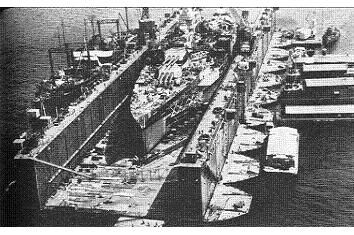![]() The Pacific War Online Encyclopedia
The Pacific War Online Encyclopedia
|
| Previous: Fletcher, Frank Jack | Table of Contents | Next: Flower Class, British Corvettes |
Among the logistical marvels employed by the U.S. Navy in the Pacific were various kinds of floating dry docks. These were towed to advanced bases by tugs and came in a variety of sizes.
Planning for floating dry docks was prompted by the fortifications clause of
the Washington
Naval Treaty, which forbade any further development of bases
in the western Pacific. Construction of floating dry docks was
given high priority and the docks were regarded as an important
"secret weapon" in the event of war with Japan. Plans were even considered
for giving the largest floating dry docks their own propulsion plants to
increase their mobility. However, tight funding in peace time
meant that construction of the docks took place only slowly.
At the time war broke out in the Pacific, the Navy had three steel floating dry docks. One, YFD-2, was assigned to Pearl Harbor and was occupied by destroyer Shaw when the harbor was attacked on 7 December 1941. Both destroyer and dry dock were badly damaged but subsequently repaired. Another, Dewey, was at Olongapo and was scuttled to prevent it falling into Japanese hands. The third, ARD-1, was built in 1933 to a sophisticated design, meant to be self-sustaining once towed into place at an advanced base. It had its own ballast pumps, power station, machine shops, and crew accommodations, and could lift ships of up to 2200 tons. It was also assigned to Pearl Harbor.
U.S. Navy. Via Navsource.org
Following up on the success of ARD-1, the Navy
built another 30 ARDs (Auxiliary Repair Docks) during the war,
most of which were completed in 1942-1944. Six of the
docks were 485'8" (148.0m) long and could accommodate a ship 413'
(126m)
long, 49'4' (15.0m) wide, and displacing 3500 tons or more. This
was sufficient for a destroyer
or submarine. The clear
width for the remaining units was increased to 59' (18.0m) to
accommodate an LST.
AFDs, Auxiliary Floating Docks, were built of welded steel, were
200' (61m)
long and 64' (19.5m) wide, and could lift a ship 45' (13.7m) wide
with a displacement of up to 1900
tons. This was sufficient for
smaller landing ships,
minesweepers, and patrol
craft. The first AFDs were completed in late 1943 and about 34
were completed by the end of the war.
By 1943, steel was a critical resource, and the U.S. Navy economized by constructing thirteen dry docks out of concrete. Each had a capacity of 2800 tons, enough for a large destroyer, and the dimensions were 389' by 84' by 40' (119m by 26m by 12m). The floor was divided into twelve compartments with a dry passage for personnel. Six were outfitted with diesel generators and manned by crews of 5 officers and 89 men for independent operation (the other seven remained in developed ports). Each had a 5 ton crane on each wing wall.
The concrete docks proved durable and were surprisingly popular
with their crews. Their massive construction gave them
considerable stability, and the tremendous ballast provided by the
lower hull meant that the wing walls could be outfitted with
extensive crew facilities.

U.S. Navy
ABSDs, Advance Base Sectional Docks, were huge
floating docks built
in sections. The individual sections were small enough to
withstand the
stress of being towed in heavy seas and were were welded together
once
they arrived at the advanced base. The docks came in two sizes,
with
the largest ones built out of ten sections, each 256' (78m) long
and
80' (24m) wide and with a lift of 10,000 tons. These were welded
together side to side to produce an assembled dock 927' (283m)
long and
256' (78m) wide that could lift a warship 827' (65m) long, 133'
(65m)
wide, and displacing up to 90,000 tons. This was sufficient for
any
ship in the fleet. The smaller version came in seven sections,
each
204' (62m) long and 101' (31m) wide and capable of lifting 8000
tons. When assembled, it could lift a ship 725' (221m) long
, 120' (37m) wide, and displacing up to 55,000 tons. The sections
were
given a rough hull form that allowed them to be towed at 6 to 8
knots,
with the side walls folded down to reduce wind resistance and
lower the center of gravity. They had their own diesel generators
and crew quarters. Each
assembled dock had two cranes with a lift of 15 tons that ran on
rails
atop the assembled walls of the dock.
A total of 58 ABSD sections were
constructed during the war, sufficient for three of the larger
docks
and four of the smaller docks. The first ABSD was assembled at Noumea in 1943 and a second was
being assembled at Espiritu
Santo at the end of the year. Though theoretically capable
of being disassembled and moved to a new location, this was
attempted only with the Espiritu dock (ABSD-1, later redesignated
AFDB-1 Artisan) which was moved to the Philippines just as
the war was winding down.
Total Navy floating dry dock capacity was 108,000 tons
by the end of 1942 and 723,000 tons at the end of 1943.
 |
 |
 |
 |
 |
 |
References
Angas (1945; accessed 2014-3-22)
"Building the Navy's Bases in World War II" (1947; accessed 2011-12-21)
NavSource.org
(accessed 2014-4-6)
The Pacific War Online Encyclopedia © 2006, 2011, 2013-2014, 2016 by Kent G. Budge. Index